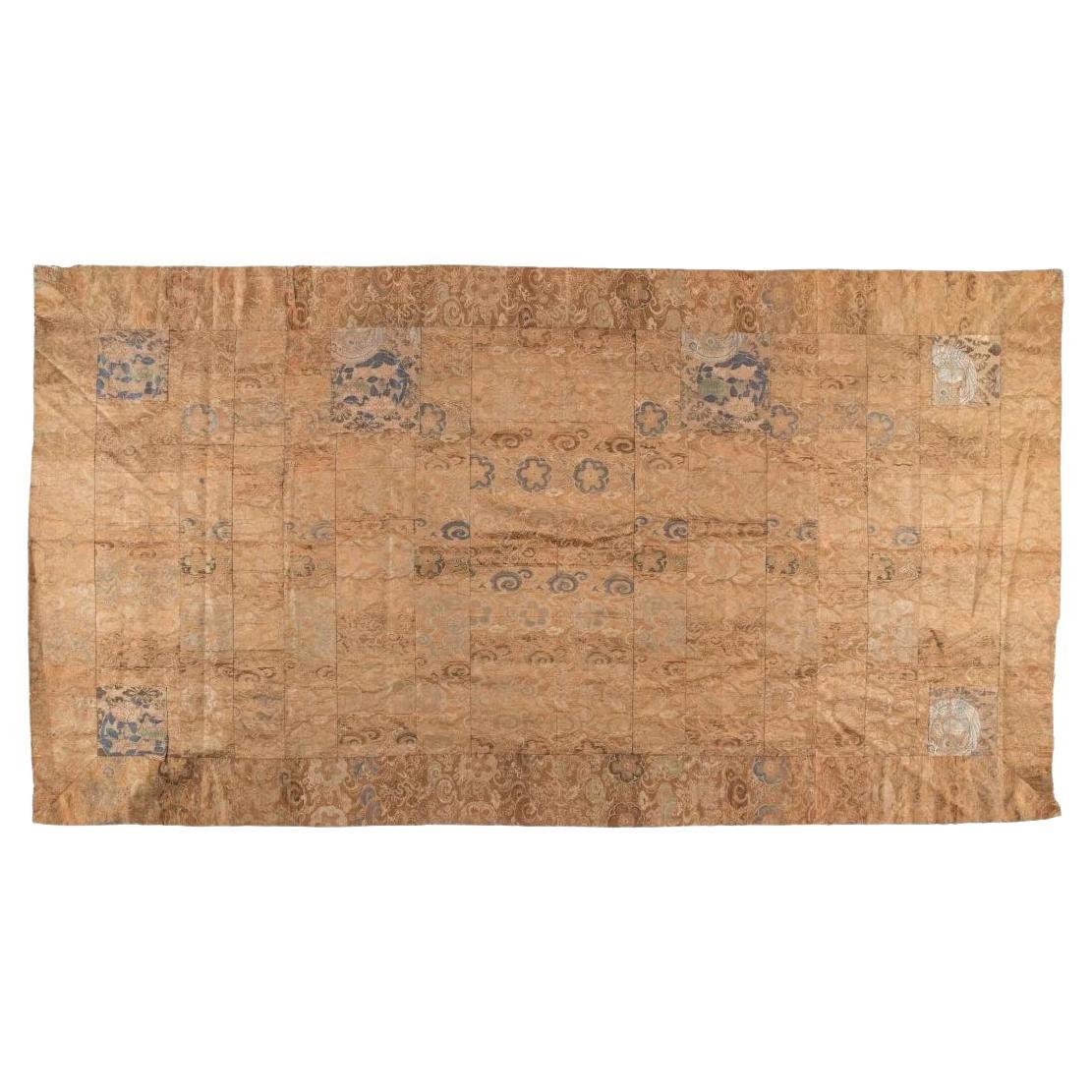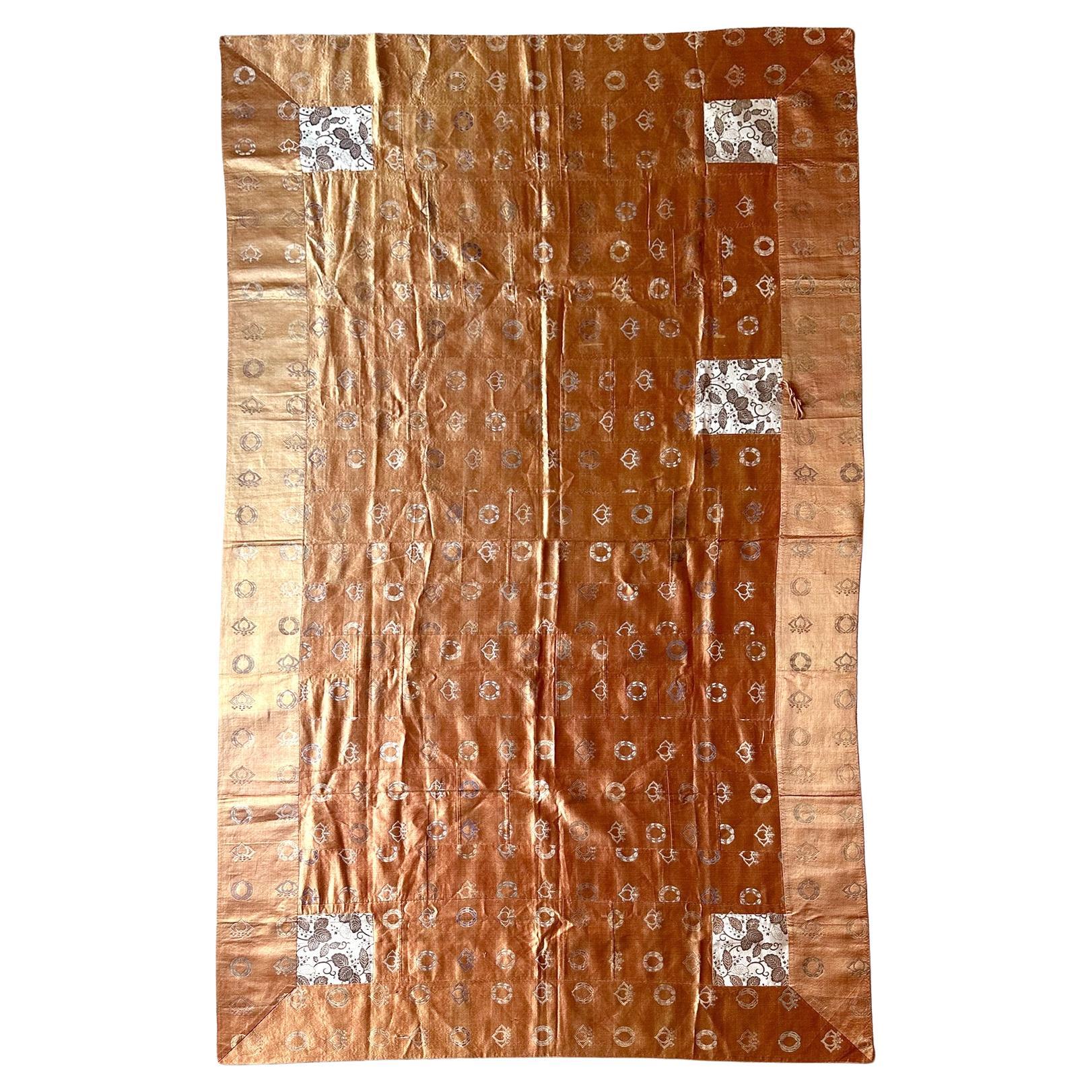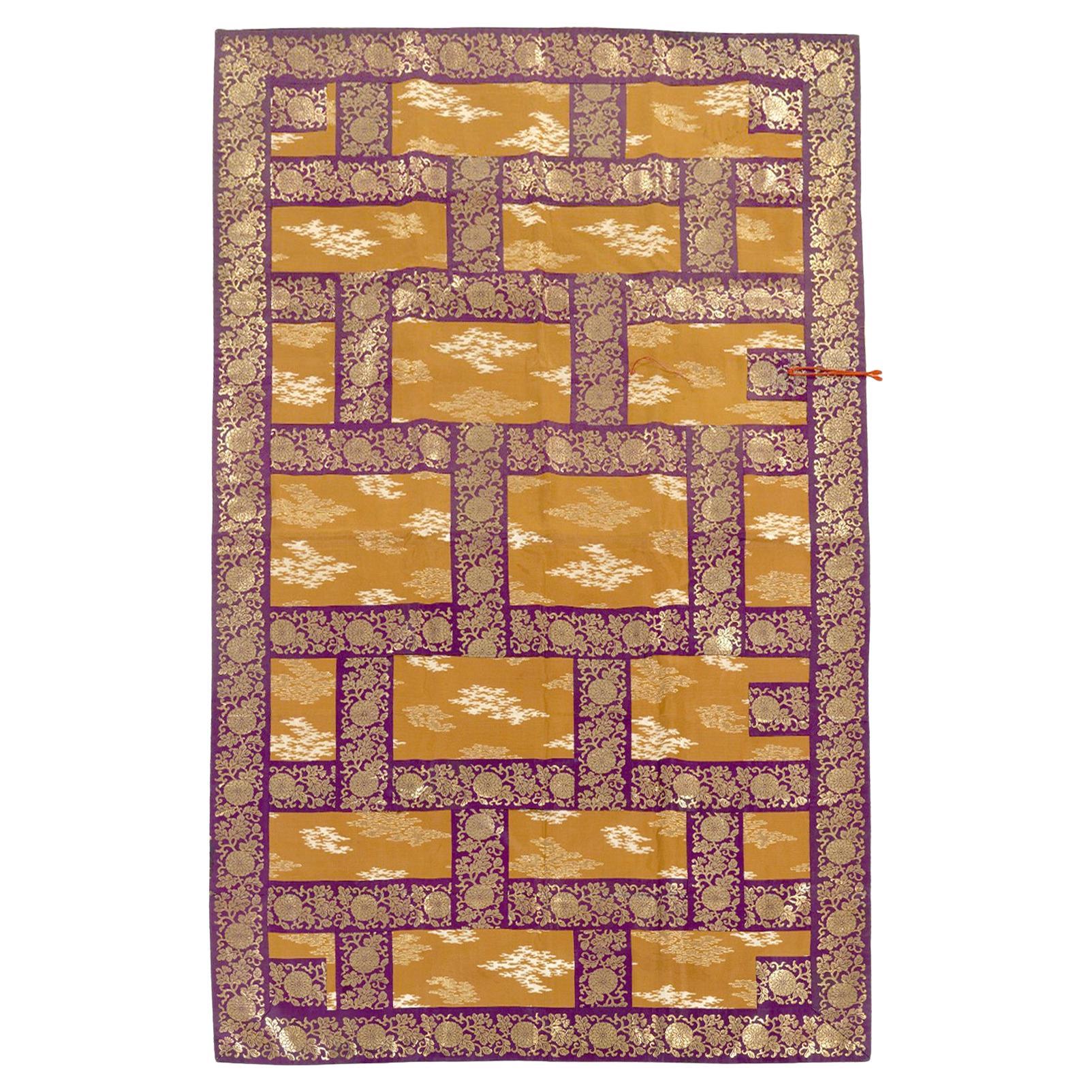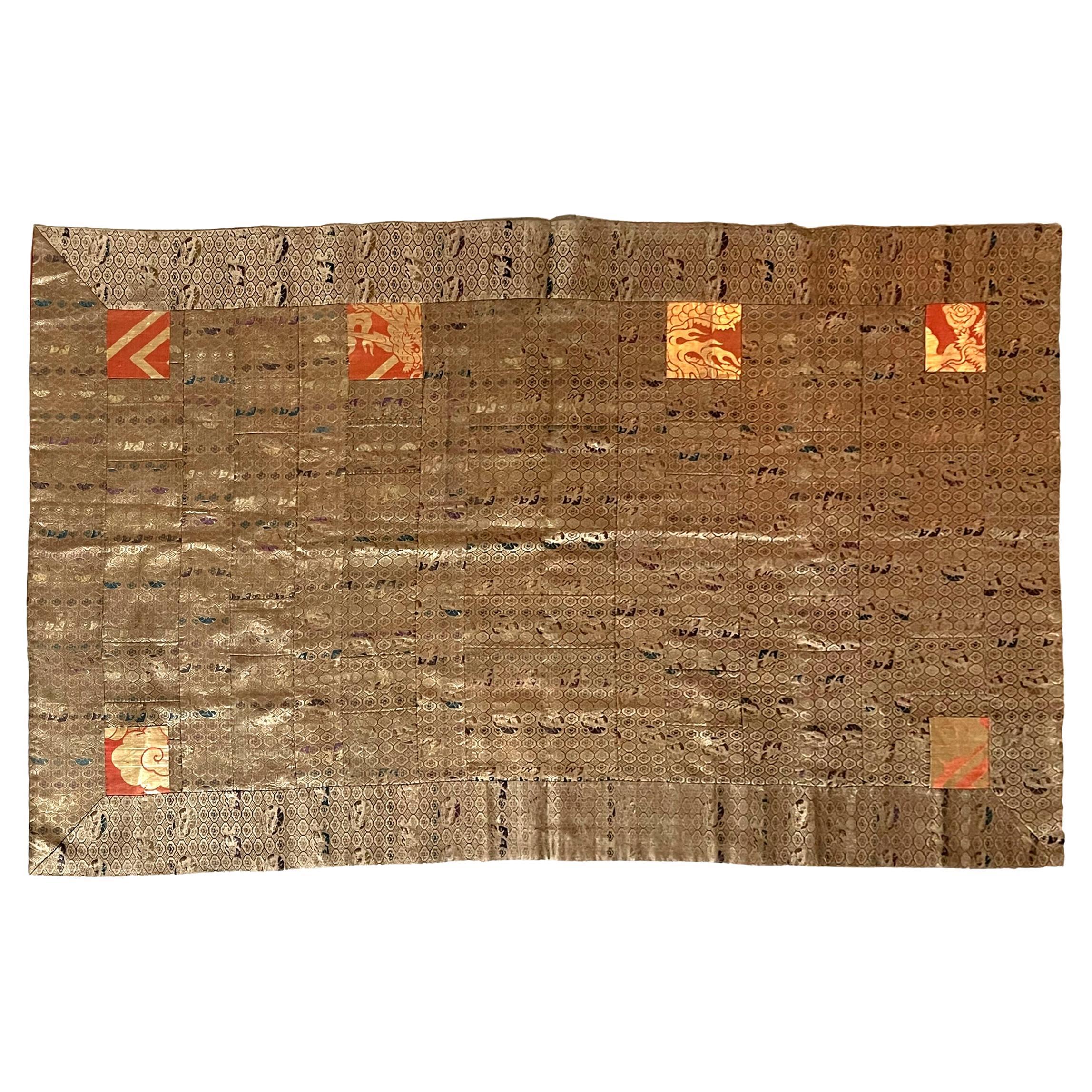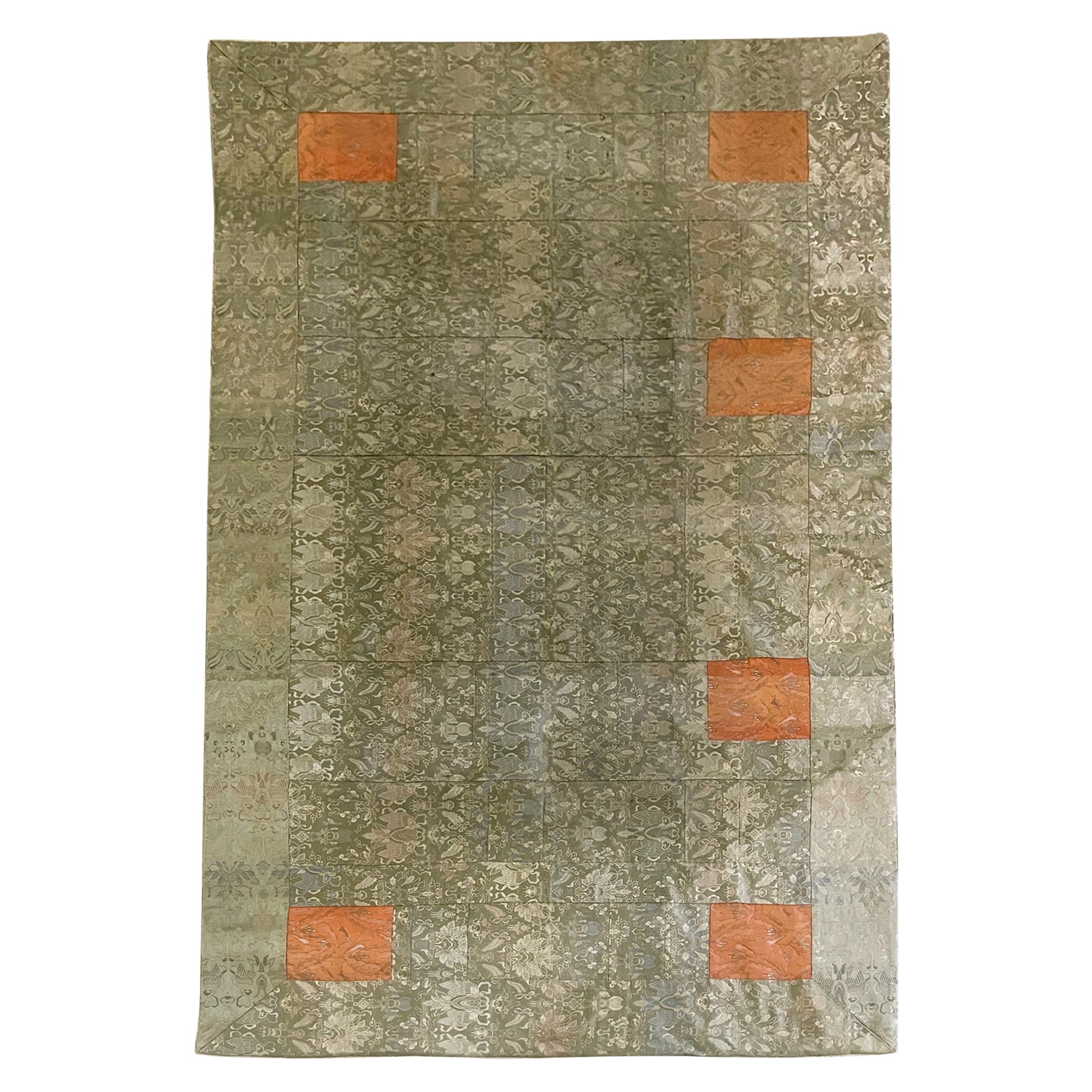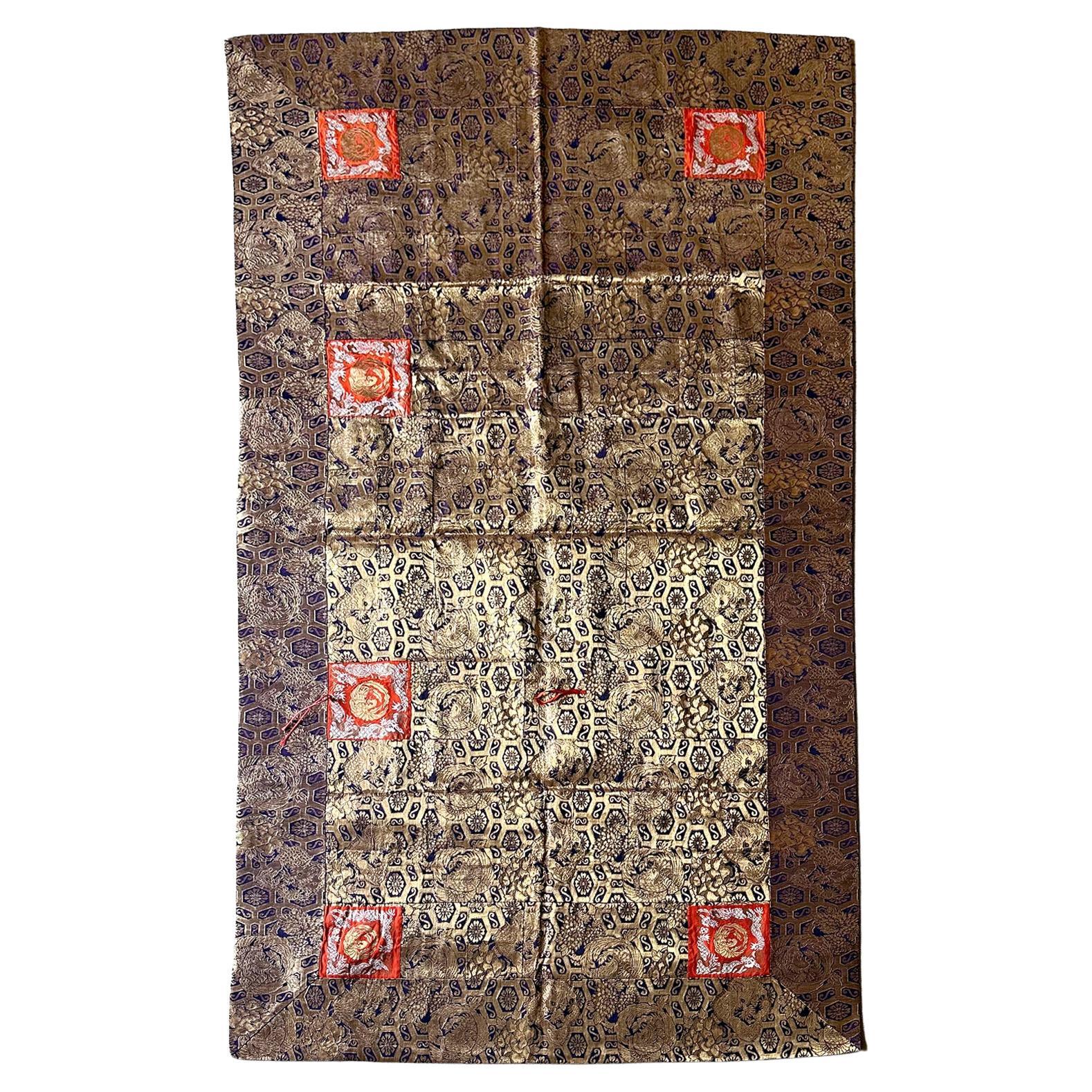Items Similar to Antique Brocade Kesa Monk's Patched Robe Edo Period
Want more images or videos?
Request additional images or videos from the seller
1 of 18
Antique Brocade Kesa Monk's Patched Robe Edo Period
About the Item
Kesa, known as "Jiasha" in Chinese and "Kasaya" in Sanskrit, is an out layer garment worn by the ordained Buddhist monks. Bearing a basic rectangular form, it developed originally in India where monks used scraps of discarded fabric to patch into a robe that was deemed scared. Kesa was worn above the left shoulder, wrapped under the right armpit and draped along the body. Originally dyed dark colors to stand out in tropical Indian weather, the garment was an identification with the ascetic nature of the monkhood. With Buddhism spread to other Asian countries such as China, Korea and Japan, this tradition of wearing kesa remained to this day. The fabrics used in creating kesa, however, was no longer rags, but gradually became luxurious due to the donation from the worshippers and benefactors of the temple. Paradoxically, the acetic aspect was maintained in the standard patched construction. Within the border, kesa was sewn together in vertical columns, from five to up tp twenty five, with seven being the most common. The higher the number, the more formal and the higher rank it may indicate of the wearer. Sometimes, six patches were placed on top, with four on corners and two flanking the middle, symbolizing the four cordial guardians and the bodhisattvas within the heart.
The kesa on offer is an authentic piece dated to Edo period (late 18th century). It was collected and labeled accordingly as shown. Featuring seven columns within its border, it was patched from four different types of brocade, finely woven in Nishiji, Kyoto, which still stands today as a landmark in the city. The fine brocade depicts a wide range of floral motifs, with bamboos on a darker background in one, and a purple peony on the other. Buddhism swastika with a slight ikat tips were heavily featured in one brocade. Although the cutting and patching were always done in random, the selection of the fabrics and colors rendered this piece a harmonious appeal. There are some staining throughout but because of the busy patterns, they may not be readily visible. There is a slightly darkening and wear including a small break of the fabric due to years of use concentrated in the middle part, where the exposure was the greatest. The backing silk has degradation in the middle as well. It is possible that some patches might be added on at different time as needed. This observation and the particular wear and patina are both in keep with the indication that this garment was used for a long time. A fabric label was sewn on the back identifying the robe, the origin of the fabric as well as its age (circa 1772, although we are no sure how this year was pinpointed down, maybe there was other accompany provenance that is now lost). Based on our research and comparison with the kesa collection in museums such as RISD and The Art Institute of Chicago, we believe that the information provided on the cloth label is largely correct.
The kesa is loose therefore requires framing for idea display. It ships easily folded up.
- Dimensions:Height: 41 in (104.14 cm)Width: 71 in (180.34 cm)Depth: 0.1 in (2.54 mm)
- Style:Edo (Of the Period)
- Materials and Techniques:
- Place of Origin:
- Period:
- Date of Manufacture:1772
- Condition:Wear consistent with age and use. Minor losses. Minor fading. Antique textile condition with patina from use. Scattered stains, more pronounced on the backing silk. Small breaks and tears found mostly in the middle section. Backing silk ripped in the middle. Preserved and present very well. Needs framing.
- Seller Location:Atlanta, GA
- Reference Number:1stDibs: LU945022981472
About the Seller
5.0
Platinum Seller
These expertly vetted sellers are 1stDibs' most experienced sellers and are rated highest by our customers.
Established in 2006
1stDibs seller since 2010
478 sales on 1stDibs
Typical response time: <1 hour
- ShippingRetrieving quote...Ships From: Atlanta, GA
- Return PolicyA return for this item may be initiated within 2 days of delivery.
More From This SellerView All
- Antique Japanese Brocade Kesa Monk's Robe Edo PeriodLocated in Atlanta, GAA Japanese Kesa (Monk's Vestment) made from thirteen columns of patchworks of shimmering woven brocades. The elaborate motifs feature repetitive hibiscus flowers within framework of ...Category
Antique 19th Century Japanese Edo Textiles
MaterialsBrocade, Silk
- Antique Japanese Embroidered Silk Kesa Monk's Robe Edo PeriodLocated in Atlanta, GAA Japanese Kesa (Monk's Vestment) made from thirteen columns of patchworks of fine shimmering silk fabric of a salmon orange color, the shade of which changed subtly from different a...Category
Antique 19th Century Japanese Edo Textiles
MaterialsBrocade, Silk
- Antique Silk Kesa Monk's Patched Robe Meiji PeriodLocated in Atlanta, GAKesa, known as "Jiasha" in Chinese and "Kasaya" in Sanskrit, is an out-layer garment worn by the ordained Buddhist monks. Bearing a basic rectangular form, it developed originally in...Category
Antique 19th Century Japanese Meiji Textiles
MaterialsTextile, Brocade
- Antique Japanese Brocade Kesa Monk's Robe Meiji PeriodLocated in Atlanta, GAA stunning Japanese Kesa (Monk's Vestment) made from thirteen columns of patchworks of shimmering woven brocades. The elaborate motifs feature repetitive...Category
Antique Late 19th Century Japanese Meiji Textiles
MaterialsBrocade, Silk
- Antique Japanese Brocade Monk's Robe Kesa Meiji PeriodLocated in Atlanta, GAA Japanese Kesa (Monk's Vestment) made from thirteen columns of patchworks of shimmering woven brocades. The elaborate motifs feature repetitive elaborat...Category
Antique Late 19th Century Japanese Meiji Textiles
MaterialsBrocade, Silk
- Magnificent Antique Japanese Woven Brocade Kesa Monk's Robe Meiji PeriodLocated in Atlanta, GAA stunning Japanese Kesa (Monk's Vestment) made from thirteen columns of patchworks of shimmering woven brocades with luxuriant golden threads. Dated to late 19th century of Meiji Period, the elaborate woven motifs on this kesa feature repetitive roundels dragon and phoenix intermixed with peonies and chrysanthemum blossoms. Two shades of contrasting gold threads were used on a striking purplish-blue background, with a dark metallic thread for the outer border and a brighter thread for the main body. The brilliantly woven fabric was possibly recycled from Noh costumes...Category
Antique Late 19th Century Japanese Meiji Textiles
MaterialsBrocade, Silk
You May Also Like
- Japanese Edo Buddhist Monk Priest 7 Column Silk Brocade Kesa Ceremonial RobeLocated in Studio City, CAA wonderful, brightly coloured and somewhat rare fully intact Japanese Buddhist monk/ priest's Kesa ceremonial silk robe. Kesa (which came from the Chinese word "kasaya") robes have been handmade/handstitched by monks/priests as an act of devotion as ceremonial robes for centuries in various Asian cultures (Japanese, Chinese, Korean, Vietnamese, Indian, etc). The kesa is a rectangular garment designed to be worn over the left shoulder (see example image). The robes are made (often in a patchwork column pattern ranging from five, seven, nine or more pannels) specifically for fully ordained Buddhist monks, priests and nuns and are made from donations of exquisite textiles from wealthy patrons of Japanese Buddhist temples. The robes were used in daily ceremonies, temple gatherings, and private meditation. Antique Kesa robes...Category
Antique 19th Century Japanese Edo Textiles
MaterialsTextile, Brocade, Silk
- Japanese Buddhist Monk Priest 7 Column Silk Brocade Kesa Ceremonial Temple RobeLocated in Studio City, CAA wonderful, beautifully ornamented and somewhat rare fully intact Japanese Buddhist monk/ priest's Kesa ceremonial silk robe featuring various colorful birds in flight. Kesa (which came from the Chinese word "kasaya") robes have been handmade/handstitched by monks/priests as an act of devotion as ceremonial robes for centuries in various Asian cultures (Japanese, Chinese, Korean, Vietnamese, Indian, etc.). The kesa is a rectangular garment designed to be worn over the left shoulder (see example image). The robes are made (often in a patchwork column pattern ranging from five, seven, nine or more pannels) specifically for fully ordained Buddhist monks, priests and nuns and are made from donations of exquisite textiles from wealthy patrons of Japanese Buddhist temples. The robes were used in daily ceremonies, temple gatherings, and private meditation. Antique Kesa robes...Category
Mid-20th Century Japanese Showa Textiles
MaterialsTextile, Brocade, Silk
- Pair of Framed Chinese Silk Brocade Chair Panels, c. 1850Located in Chicago, ILThese framed silk brocade tapestries are two halves of a magnificent Qing-dynasty chair panel, or chair strip. Because traditional Chinese seating was n...Category
Antique Mid-19th Century Chinese Qing Textiles
MaterialsSilk
- Vintage Orange Silk Japanese Obi with Gold and Silver Lamé and BrocadeLocated in Topeka, KSHandsome vintage Japanese obi in orange silk with gold and silver lamé and brocade flower and leaf design. It is in wonderful vintage condition. We have detected a small dark spot on...Category
Mid-20th Century Japanese Japonisme Tapestries
MaterialsSilk
- Late Meiji Period Sleeping Kimono / Yogi, JapanLocated in Point Richmond, CALate Meiji Period sleeping Kimono / Yogi, Japan Yogi are a type of oversized sleeping kimono traditionally used in Japan. This kimono would have b...Category
Early 20th Century Japanese Tribal Textiles
MaterialsCotton
- Meiji Period Japanese Indigo Double Ikat Futon CoverLocated in Point Richmond, CAMeiji period Japanese Indigo double ikat futon cover Japanese futon cover, a double ikat pattern in four panels depicting Kumamoto Castle with im...Category
Antique 1890s Japanese Meiji Textiles
MaterialsCotton
Recently Viewed
View AllMore Ways To Browse
Timor Textile
Small Textile
Textiles To Frame
Brocade Used
Long Textiles
The Robe
Asian Authentic Furniture
Antique Robe
Antique Robes
India Textiles
India And Textile
Framed Fabric Textiles
Antique Fabric Fabric Textiles
Antique Fabric Textiles
Antique Textiles Fabric Textiles
Purple Textile
Antique Fabrics And Textiles Fabric Textiles
18th Century Textiles
